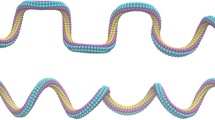Abstract
Vimentin coiled-coil alpha-helical dimers are elementary protein building blocks of intermediate filaments, an important component of the cell’s cytoskeleton that has been shown to control the large-deformation behavior of eukaryotic cells. Here we use a combination of atomistic simulation and continuum theory to model tensile and bending deformation of single alpha-helices as well as coiled-coil double helices of the 2B segment of the vimentin dimer. We find that vimentin dimers can be extended to tensile strains up to 100% at forces below 50 pN, until strain hardening sets in with rapidly rising forces, approaching 8 nN at 200% strain. We systematically explore the differences between single alpha-helical structures and coiled-coil superhelical structures. Based on atomistic simulation, we discover a transition in deformation mechanism under varying pulling rates, resulting in different strength criteria for the unfolding force. Based on an extension of Bell’s theory that describes the dependence of the mechanical unfolding force on the pulling rate, we develop a fully atomistically informed continuum model of the mechanical properties of vimentin coiled-coils that is capable of predicting its nanomechanical behavior over a wide range of deformation rates that include experimental conditions. This model enables us to describe the mechanics of cyclic stretching experiments, suggesting a hysteresis in the force–strain response, leading to energy dissipation as the protein undergoes repeated tensile loading. We find that the dissipated energy increases continuously with increasing pulling rate. Our atomistic and continuum results help to interpret experimental studies that have provided evidence for the significnificance of vimentin intermediate filaments for the large-deformation regime of eukaryotic cells. We conclude that vimentin dimers are superelastic, highly dissipative protein assemblies.














Similar content being viewed by others
References
Alberts B et al (2002) In: Molecular biology of the cell. Taylor & Francis
Strelkov SV, Herrmann H, Aebi U (2003) BioEssays 25:243
Burkhard P, Kammerer RA, Steinmetz MO, Bourenkov GP, Aebi U (2000) Structure 8:223
Herrmann H, Aebi U (2004) Annu Rev Biochem 73:749
Strelkov SV, Herrmann H, Geisler N, Wedig T, Zimbelmann R, Aebi U, Burkhard P (2002) EMBO J 6:1255
Kiss B, Karsai A, Kellermayer MSZ (2006) J Struct Biol 155:327
Janmey PA, Euteneuer U, Traub P, Schliwa M (1991) J Cell Biol 113:155
Mücke N, Wedig T, Bürer A, Marekov L, Steinert P, Langowski J, Aebi U, Herrmann H (2004) J Mol Biol 340:97
Smith TA, Strelkov SV, Burkhard P, Aebi U, Parry DAD (2002) J Struct Biol 137:128
Wilson KL, Zastrow MS, Lee KK (2001) Cell 104:647
Wang N, Stamenovic D (2003) J Muscle Res Cell Motil 23:535
Mücke N, Kreplak L, Kirmse R, Wedig T, Herrmann H, Aebi U, Langowski J (2004) J Mol Biol 355:2342
Helfand BT, Chang L, Goldman RD (2004) J Cell Sci 117:133
Smith TA, Hempstead PD, Palliser CC, Parry DAD (2003) Proteins 50:207
Kreplak L, Aebi U, Herrmann H (2004) Exp Cell Res 301:77
Strelkov SV, Schumacher J, Burkhard P, Aebi U, Herrmann H (2004) J Mol Biol 343:1067
Moir RD, Spann TP (2001). Cell Mol Life Sci 58:1748
Coulombe PA, Bousquet O, Ma L, Yamada S, Wirtz D (2000) Cell Biol 10:420
Fudge DS, Gosline JM (2004) Proc R Soc Lond 271:291
Fudge DS, Gardner KH, Forsyth VT, Riekel C Gosline JM (2003) Biophys J 85:2015
Eckes B, Dogic D, Colucci-Guyon E, Wang N., Maniotis A, Ingber D (1998) J Cell Sci 111:1897
Brown MJ, Hallam JA, Colucci-Guyon E, Shaw S (2001) J Immunol 166:6640
Nieminen M, Henttinen T, Merinen M, Marttila- Ichihara F, Eriksson JE, Jalkanen S (2006) Nat Cell Biol 8:156
Kreplak L, Bär H, Leterrier JF, Herrmann H, Aebi U (2005) J Mol Biol 354:569
Storm C., Pastore JJ, MacKintosh FC, Lubensky TC, Janmey PA (2005) Nature 435:191
Guzmán C, Jeney S, Kreplak L, Kasas S, Kulik AJ, Aebi U, Forró L (2006) J Mol Biol 360:623
Omary MB, Coulombe PA, Irwin McLean WH (2004) N Engl J Med 351:2087
Schietke R, Broehl D, Wedig T, Muecke N, Herrmann H, Magin TM (2006) Eur J Cell Biol 85:1
Schwaiger I, Sattler C, Hostetter D, Rief M (2002) Nat Mater 1:232
Akkermans RL, Warren CPB (2004) Phil Trans R Soc Lond 362:1783
Root DD, Yadavalli VK, Forbes JF, Wang K (2006) Biophys J 90:2852
Cieplak M, Hoang TX, Robbins MO (2002) Proteins: Struct Funct Genet 49:104
Rohs R, Etchebest C, Lavery R (1999) Biophys J 76:2760
Bornschloegl T, Rief M (2006) PRL 96:118102
Mitsui J, Nakajima K, Arakawa H, Hara M, Ikai A (2000) Biochem Biophys Res Commun 272:55
Hanke F, Kreuzer HJ (2006) Phys Rev 74:031909
Evan E, Ritchie K (1997) Biophys J 72:1541
Dudko OK, Hummer G, Szabo A (2006) PRL 96:108101
Wiita AP, Ainavarapu SRK, Huang HH, Fernandez JM (2006) PNAS 103:7222
Gilli P, Bertolasi V, Pretto L, Gilli G (2006) J Mol Struct 790:40
Bell GI (1978) Science 200:618
Lu H, Isralewitz B, Krammer A, Vogel V, Schulten K (1998) Biophys J 75:662
MacKerell AD et al (1998) J Phys Chem 102:3586
Courtney TH (1990) In: Mechanical behaviour of materials. McGraw-Hill
Humphrey W, Dalke A, Schulten K (1996) J Mol Graphs 14:33
Sheu SY, Yang DY, Selzle HL, Schlag EW (2003) PNAS 100:12683
Inoué S, Salmon ED (1995) Mol Biol Cell 6(12):1619
Papadopoulos P et al (2006) Biomacromolecules 7:618
Buehler MJ, Wand SY (in press) Entropic elasticity controls nanomechanics of single tropocollagen molecules
Buehler MJ (2007) J Mech Mater Struct (in print)
Baker D (2000) Nature 405:39
Acknowledgements
TA acknowledges the support of the German National Academic Foundation and the Dr.-Juergen-Ulderup Foundation. This research was partly supported by the Army Research Office (ARO), grant number W911NF-06-1-0291, program officer Dr. Bruce LaMattina. We acknowledge fruitful discussions with Professor Harald Herrmann (University of Heidelberg, Germany) and Professor Laurent Kreplak (University of Basel, Switzerland).
Author information
Authors and Affiliations
Corresponding author
Rights and permissions
About this article
Cite this article
Ackbarow, T., Buehler, M.J. Superelasticity, energy dissipation and strain hardening of vimentin coiled-coil intermediate filaments: atomistic and continuum studies. J Mater Sci 42, 8771–8787 (2007). https://doi.org/10.1007/s10853-007-1719-2
Received:
Accepted:
Published:
Issue Date:
DOI: https://doi.org/10.1007/s10853-007-1719-2




